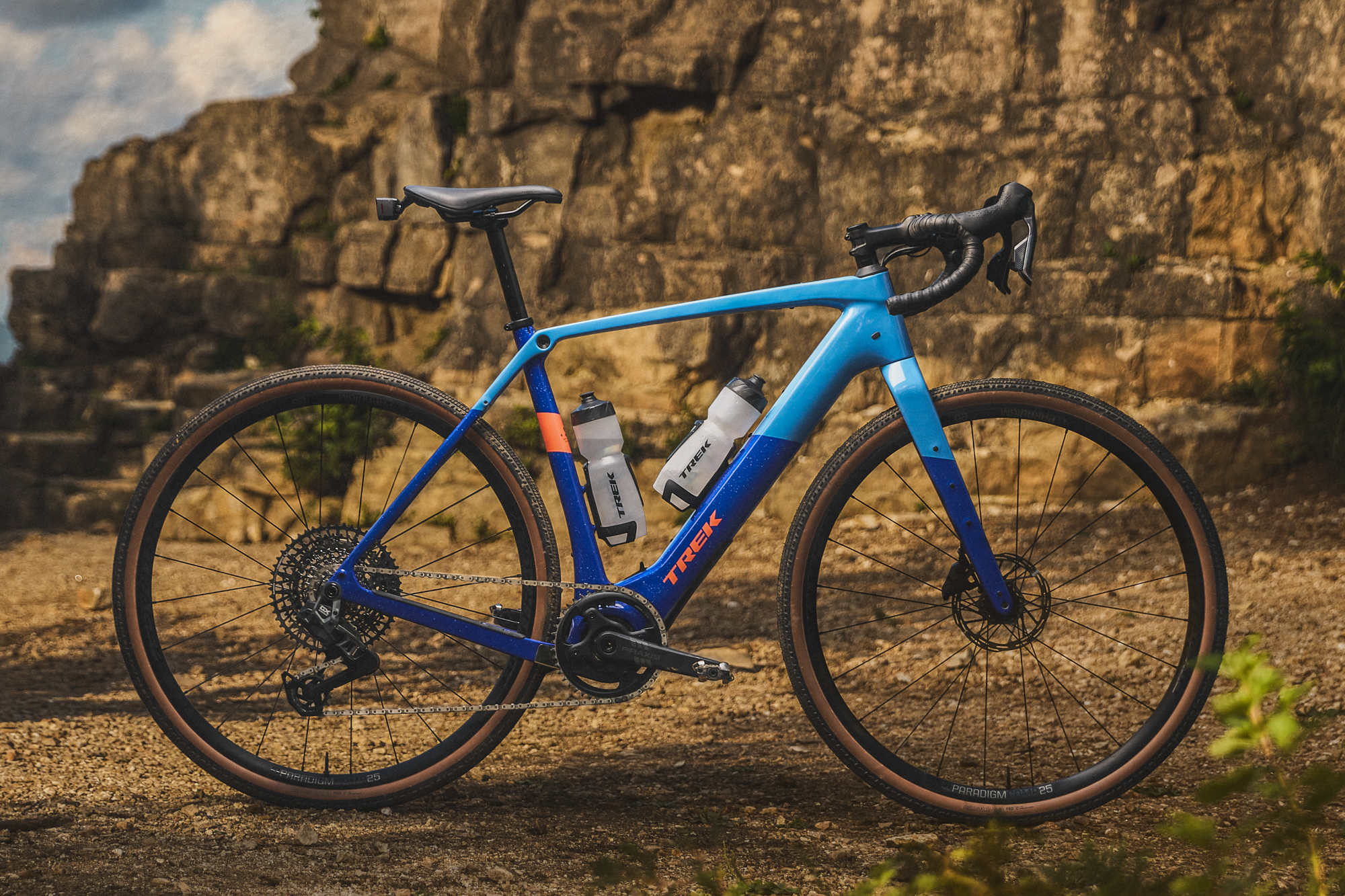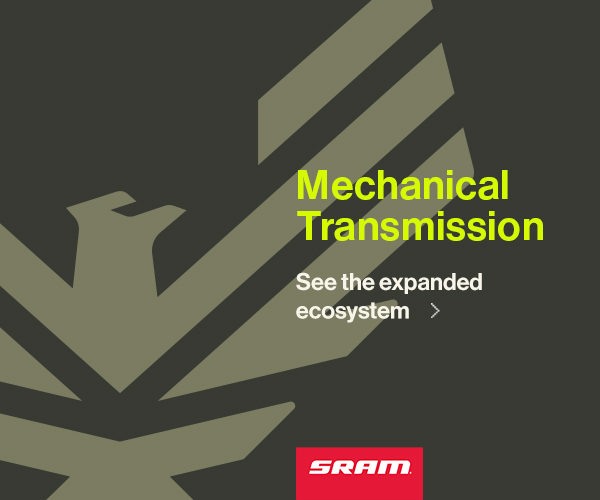Travis Engel got his hands on the new Trek Checkpoint + SL 6 AXS after being torn about the necessity of an “e-gravel” platform. Read on to see what changed for him…
I remember rolling my eyes the first time I heard someone say “e-gravel bike.” I didn’t really see the point. An e-commuter allows riders to do your errands with less time and less effort. And an e-MTB allows riders to bag more trails per hour … whether or not it’s legal. But I had thought gravel (and road) bikes were primarily about the challenge. E-gravel sounded a bit like e-pilates or e-bench-pressing. It ruins the activity’s whole appeal: The struggle.
But I came to that conclusion from a place of privilege. My career consists of one written story a week, my family consists of one very understanding spouse, and my go-to drop-bar route consists of a network of closed roads ten minutes from my house. If struggle weren’t so easy for me, I’d probably want an e-gravel bike. And I’d probably want one like the Trek Checkpoint +.



Trek Checkpoint + SL 6 AXS Quick Hits:
- New TQ HPR60 motor with 60 nm of torque
- 360 watt-hour battery (compatible with 160 wh extender)
- Carbon frame
- Trek IsoSpeed vibration-damping seat-tube design
- Available with either a rigid fork (tested), or a 40mm-travel RockShox Rudy
- 50mm max recommended tire clearance
- Three-pack mounts on fork, rack mounts on rear triangle, and fitted for frame bags available from Trek
- Price: $6,599 (SL6 build tested)
- $5,999 for cable-actuated GRX SL5 build, $7,999 for front-suspended SL7 build
The Checkpoint + is on the opposite end of the spectrum from the Salsa Tributary Spencer reviewed with Jarrod last year. Both are class-3 e-bikes, meaning those sold in the US will assist up to 28 mph. But I might argue that Tributary is more of a drop-bar e-MTB because of its 2.6” tire clearance, 120mm suspension fork, and full-power motor and battery. The Trek Checkpoint + platform is decidedly lighter-duty, with a carbon frame and non-boost spacing. It’s available either fully rigid or front-suspended, but the travel maxes out at 40 mm and the tire width maxes out at 50 mm. The battery is relatively small at 360 watt-hours (plus an optional 160 wh external extender), and the motor provides a relatively conservative 60 nm of torque. That motor is the new HPR60 from TQ. We’re generally not e-bike nerds here at The Radavist, but the tech inside a TQ motors has me wiping the steam off my thick-framed, taped-together glasses.

On their own, electric motors great at spinning fast, but not as great at spinning hard. That’s why e-bike motors use some form of mechanical gear reduction. Usually, that reduction happens in a gearbox. But TQ uses something called a Harmonic Pin Ring mechanism. It’s a simpler, quieter, smoother way to trade speed for torque. To give you an idea how smooth, TQ’s background is in remote-controlled surgery robots. And as you might suspect, the HPR60 is also relatively compact because both the motor and the reduction mechanism are concentric with the bottom bracket spindle.

Think of Harmonic Pin Ring reduction like a Spirograph, where you put the tip of a pencil through a hole in a flat plastic gear. You then use the pencil to roll that gear around inside a larger “ring gear.” The plastic gear will undulate as you make spirals with your pencil. But you’ll have to make a lot of spirals before the flat plastic gear itself rotates 360°, especially when that gear is only slightly smaller than the ring gear. That’s essentially how the TQ’s gear reduction works. The motor helps turn an off-center spindle (acting like the pencil) that drives a unique rounded-tooth gear (acting like the Spirograph undulating gear) inside a fixed outer gear (acting like the Spirograph ring gear). The rotation of that unique rounded-tooth ring drives another off-center spindle, and that’s what turns the chainring.

It’s a good fit for e-gravel when you want a bike to feel quick and light, and you aren’t surrounded by the chaos of technical rock climbs, or the rattling of groceries, or the sounds of your toddlers singing along with Pink Fong. It’s also not a category that requires the 85-plus nm of torque common on an e-MTB, though the new HPR60 motor does offer 10 more nm than the HPR50 that preceded it. A lightweight, mild-mannered e-gravel bike is the perfect home for this kind of motor.

Trek Checkpoint + First Impressions
I did a quick loop on the Checkpoint + outside Colorado Springs a couple weeks ago that stretched about 27 miles with 2,800 feet of climbing. It started with a mix of paved, gravel and singletrack uphills, and it ended with a long, loose fire-road descent. Overall, the pace was moderate because it was a big group of non-locals, including at least one rider on a non-motorized gravel bike. That happened to be Alex Bedinghaus, a product manager at Trek. He’s extremely fit, but not fit enough to keep pace with a bunch of geezers in turbo mode. So we turned our bikes down, but not off. And it’s pretty remarkable that the Checkpoint + can remain practical in that kind of mixed company.
I spent most of my time swapping between “eco” and “mid” via the buttons tucked into the base of each brake hood. It’s nice to cycle assist modes like cycling through gears, though there was no noise or tactility to that cycling. I was sometimes uncertain which mode I was in. But there was no uncertainty when I tried an occasional sprint in “high,” or a curious dip into “off.” Even the mid-power HPR60 motor felt like a chairlift in its strongest setting. And although Trek and TQ claim their system creates very minimal drag when assist is disabled, there was unmistakably some drag. At the very least, I could feel the bike’s weight. I don’t think I’d have a great time if I ever had to do a significant amount of climbing on the Checkpoint + without the motor chipping in. But crunching the numbers, I reckon that wouldn’t happen on any “reasonable” loop. Our 2800-vertical-foot ride left most of us with more than 40% battery left in the tank. And if I wasn’t probing the higher assist levels for the purpose of this review, I would have left a lot more.
Even when using a range extender and sticking in eco mode, the Checkpoint + probably won’t be bagging many dirt centuries without regularly coming home on empty. But it could definitely bang out 50 or 60 good hard miles if I was on a tight schedule. Or more importantly, it could do 50 or 60 casual miles if I ever wanted to hang with someone like Alex again. Assuming I could nobly suffer the slings and arrows that would await me if I brought an e-bike to a non e-bike ride, I’m confident I could find a setting on the Checkpoint + that would allow me to break a sweat without breaking away.

And it’s nice that it’s pretty quiet. Not silent, of course. There’s a constant hum, but it’s significantly less whiny than a Bosch. And the hum’s volume doesn’t ramp up as drastically when sprinting in eco or soft-pedaling in turbo. More importantly, the torque doesn’t ramp up as drastically either. It’s the kind of motor that fades into the background. I’m mostly familiar with higher-powered e-MTB assist modes where I feel—and often want—a sudden torque-y boost whenever I step on it. But the Checkpoint + isn’t into that. It’s more gentle. That was really helpful on the dry, hard singletrack climbs we did. A more froggy motor might have frequently broken the minimalist rear tire’s minimal traction around our climb’s many switchbacks. But the Checkpoint + motor remained a bit more calm and predictable.

That also applied to its behavior in high-speed pavement sections. There wasn’t a jerky cut-off when I hovered around peak assistance. And as a quick aside on that topic, I think assistance up to 28 mph is a must for a road-oriented e-bike. You might as well go fast if you’re already carrying the weight and the credit-card balance associated with an e-bike. Even in the US, some e-bikes are capped at 20 mph, but it’s not hard to hold that speed on flat ground. Sustaining 28 mph, on the other hand, is something special. It’s exhilarating. So much so that the adrenaline kinda motivates you to meet the motor halfway, so it isn’t necessarily a drain on the range. That speed also makes it easier to integrate with car traffic, especially in dense urban environments. It does require some common sense when you’re also riding with non-motorized users. But you know that. I don’t include a detailed “use common sense” disclaimer in any of my other reviews, so I won’t include one here.




Of course, the Checkpoint + is more than a motor. It’s also a bike. And by 2025 standards, it’s a relatively traditional one … mostly. It’s compatible with gravel-specific suspension forks, and even has Trek’s IsoSpeed vibration-damping seat-tube assembly. And in fitting with their e-bike-ness, all Checkpoint + models use a wide-range 1x drivetrain. But otherwise, the ride is pretty down-the-middle. No short stems, no steeply sloping top-tubes, no high stack heights. And although there’s cable-routing accommodations, no dropper posts. I think that’s a missed opportunity. It’s a 27.2 seat tube, which slightly limits your dropper travel range, but having something would be better than having nothing. The added weight and price would be proportionately insignificant considering the weight and price of this category. And although the SRAM AXS models will easily pair with a wireless RockShox Reverb post, the lower-priced Shimano GRX builds do not come with a dropper-actuating left brake lever. That burdens dropper adopters with installing an external drop-bar dropper remote, or incurring unnecessarily significant extra cost if they want integrated actuation.



Trek Checkpoint + Spec and Value
There are three levels of the Checkpoint +. The SL5 uses a cable-actuated Shimano GRX drivetrain and goes for $6,000, the SRAM Rival / GX AXS Transmission SL6 I tested goes for $6,600, and the SL7 adds a 40 mm RockShox Rudy fork and some higher-end parts for $8,000. Although I’m a big fan of gravel suspension, I think the SL6 is the sweet spot. It’s hard to compare value because the TQ motor is so unique, and also so rare on North American brands (for now). But the Checkpoint + prices are about average for a non-consumer-direct bike that you can buy at your local shop. Again, a very different bike, but there’s a wireless-shifting, front-suspended, carbon-frame Salsa Tributary for $6,500. But Specialized’s AXS, carbon e-gravel line doesn’t start below $7K, and you don’t get a Transmission derailleur or front suspension. So, given that the Checkpoing + prices were set during the tarriff madness, and aren’t a leap beyond the competitors, I’d say the value isn’t bad. I still wish they had droppers, though.

But there were other journalists in attendance, and they work the gravel-bike beat more regularly than I do. I was the only one loudly complaining about the lack of a dropper post. I think that means the Checkpoint + takes the approach that e-gravel is still gravel. It’s not about seeking descents where you can let loose. It’s about covering relatively diverse ground at relatively high speed. It just happens to be able to do more of it in less time.
Pros:
- Smooth, quiet motor
- Moderate torque is ideal for a traditional gravel application
- 28 MPH (in US) is huge perk for paved sections and navigating traffic
- Compatible with suspension, though it’s not required
- Relatively lightweight
- Has the bones of a relatively traditional gravel bike
Cons:
- Has the bones of a relatively traditional gravel bike
- Epic all-day rides will require careful power management and/or a range extender
- No droppers are specced in the lineup, and installing one may require a costly brake-lever swap
See more at Trek









